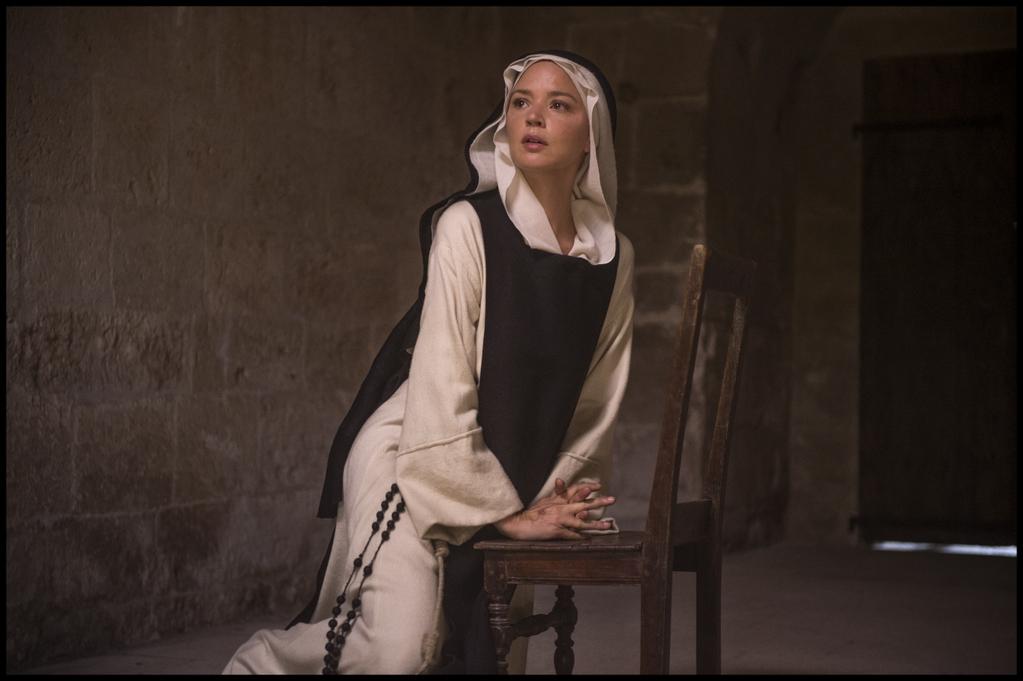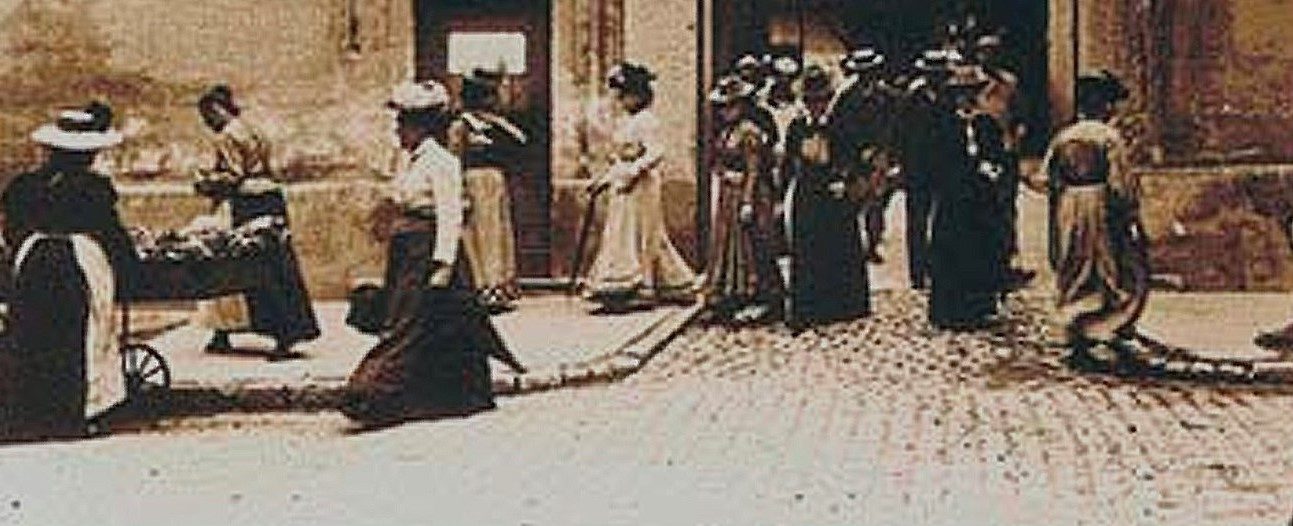France, 2020
Directed by Paul Verhoeven
With Virginie Efira (Benedetta Carlini), Daphné Patakia (Bartolomea), Charlotte Rampling (the abbess), Lambert Wilson (the nuncio), Olivier Rabourdin (Alfonso Cecchi), Louise Chevillote (Sister Christina)

“Born of well-to-do parents, Benedetta Carlini entered the convent at age nine. At twenty-three, she began to have visions of both a religious and erotic nature. Benedetta was elected abbess largely because of these visions, but she later aroused suspicion by claiming to have had supernatural contacts with Christ. During the course of an investigation, church authorities not only found that she had faked her stigmata, but uncovered evidence of a lesbian affair with another nun, Bartolomea”.
This an excerpt from the blurb printed on the paperback edition made by the Oxford University Press of the text that is the film’s source, “Immodest Acts, The Life of a Lesbian Nun in Renaissance Italy”, first published in 1986 in the United States by scholar Judith C. Brown, a “specialist on the Italian Renaissance, [who] is considered a pioneer in the study of the history of sexuality”, according to Wikipedia (the English-speaking version). Clearly her findings in old archives were a sensation, and what happened to this young woman in the Tuscany of the 17th century has now inspired veteran Dutch filmmaker Paul Verhoeven.
His movie may be taking some liberty with what has been searched, certainly trying to fill in gaps left by the distance in time and to flesh out the characters. The vision it holds is rather bold and complicated, even as the imagery is predictably sultry and provocative, when it is not look rather naive as far as the visions are concerned, even if it is spiced up with gory and CGI effects more fitting with the clang and crash of his forays in sci-fi territory.
In French, it is known that the nuns of a convent can call themselves “les fiancées de Dieu, ou de Jésus”, the betrothed of God, or of Christ, as if taking vows was like making an engagement and love of the divinity implied a contract of marriage that is only greater. Clearly, Benedetta Carlini seems to live her engagement in more than a spiritual way: her visions increasingly imply that the Christ deals with her in a physical way. The claim He has switched her biological heart for another one is not just a metaphor: it is illustrated as a genuine transformation, only without a surgeon, and it is part of a relation that is fully physical and sexual, including kisses on the lips and touching genitalia. Mysticism feeds on carnal knowledge.
Challenging even more the nun is the sudden arrival at the convent of a peasant girl harassed by her father, Bartolomea. On the very first night in the convent, Bartolomea, who has everything of a little, but charming, wild animal, troubles Benedetta and forces a physical closeness and a coarse familiarity which are ill-advised in such a place. Actually, in the view of a convent and any good Christian, Bartolomea stands as a glaring and shocking instance of devilish temptation. But Benedetta gets attracted and embraces Bartolomea as a true, perfect partner, as readily and strongly as she accepts the physical embrace of Christ – the lesbian love experienced as the earthly, human complement, extension of the godly one.
The sex toy the two nuns makes is a telling, overly significant in fact, symbol: the base of a wooden, colored statuette representing the Virgin Mary that was a precious gift of Benedetta’s mother, the only object she still have from her childhood, is shaped to look like a penis. This is the most implausible and shocking dildo that can be imagined, but its origin and its use emphasize the stunningly peculiar but coherent vision of the nun. With Benedetta, aspiring to be one with God is not just a matter of rites and routines, not even a mere, though intense, spiritual belief: all barriers between mind and flesh, belief and sex, God and humans are knocked down, and what is left is a fantastic conception of unity where eroticism is as much a way to salvation than revelation – this vision is not that far from certain mystic ideas from the East, but deeply unorthodox, to say the least.
And perhaps not really credible. Obviously the convent’s abbess has her doubts, shared by her daughter, Sister Christina – their reluctance to view the young nun first as a living miracle and then as the new abbess would cause an official investigation, and much tragedies. But the film cleverly sows doubts while shooting candidly, realistically, the most amazing developments, like the sudden distortions of Benedetta’s voice, as if Jesus was really speaking through her. The film constantly suggests that something incredible is taking place under our eyes, but some images may be difficult to be taken at face value precisely because of they are so extraordinary and stunning. The visions Benedetta has are plain aberrations suddenly altering the clear-cut narrative but the way the film goes back to real life does convey the idea that they have genuinely seized Benedetta out of the blue and completely, disrupting the mundane tasks she was performing with others – so, they may be hallucinations, but they do have an impact and the fact that she is wrecked by them is clear.
Yet, at key moments, the camera focuses on a detail hinting that some trickery is at play. So we become, in a remarkable way, like Bartolomea: tempted to believe her, mesmerized by her, and yet reckoning she may be cheating and lying. If Bartolomea at the end no longer put up with the assertions and over-confidence of her lover, and breaks up with Benedetta, the audience can still wonder what to think really of this most astonishing character, whose passion and pride intensely shape her attitudes and words, in a most daring but also most annoying manner. If she is true, she is awe-inspiring for sure, if she is a fake, she is amazingly, but enticingly, cheeky. Whatever way, she is fascinating.
And an even bigger question mark for the believers. The film casually notes how the character becomes a popular figure, before the end, and the threat of getting burned alive after her trial by a nuncio, shows how much the local population worships her. But the most important investigation deals with the inner workings of the Church, from the recruitment of novices – which is a business transaction that does not own up to its nature, and is shot with pleasant but biting irony – to the overweening, ruthless, and hypocritical management by a nuncio of both his private apartments and a trial, or to put it more accurately, a cruel and scandalous travesty of a trial.
The film emphasizes how a miracle can be used for jockeying for power and prestige, with a provost keen on promoting Benedetta to settle scores, and make money (such a character is a wonderful magnet for pilgrims and their money, after all), even as the events sorely test faith and personal experiences – it appears, in a final, poignant move, that part of the hatred of the abbess for Benedetta comes from the fact that the young woman has perhaps achieved what the older has failed over a life of prayers and rules, that is hearing the voice of God, evidence of a Church whose tenets may be elusive to its own members. Set as plague is again hitting central Italy, the story of Benedetta copes in a highly dramatic, sensational fashion, but sensibly and skillfully, with key questions about the meaning of faith, its relations to love and sentiments, the strength and sincerity of any institution pretending to defend it. At the same time, it is an unabashed celebration of the woman’s body (with the nudity of Virginie Efira and Daphné Patakia splendidly shot) and of a woman’s strength and passion.

